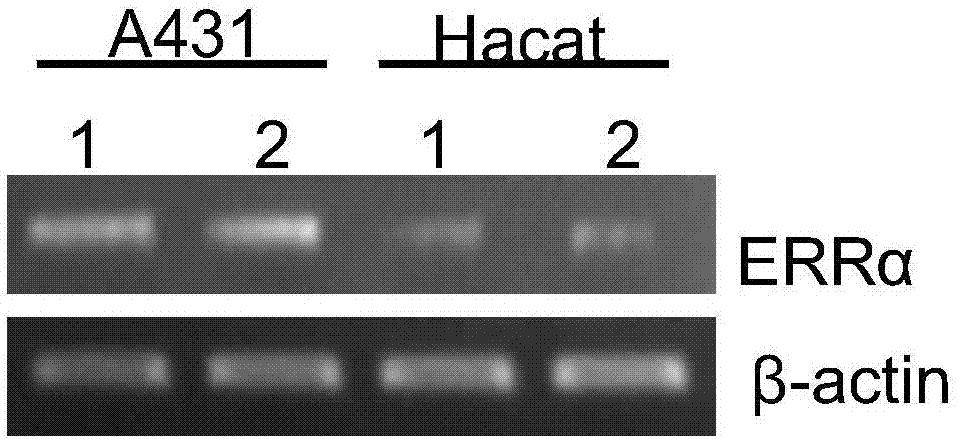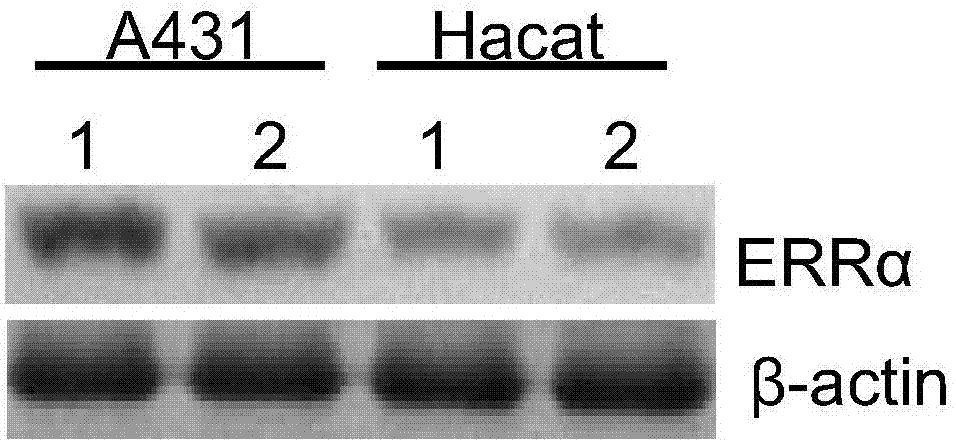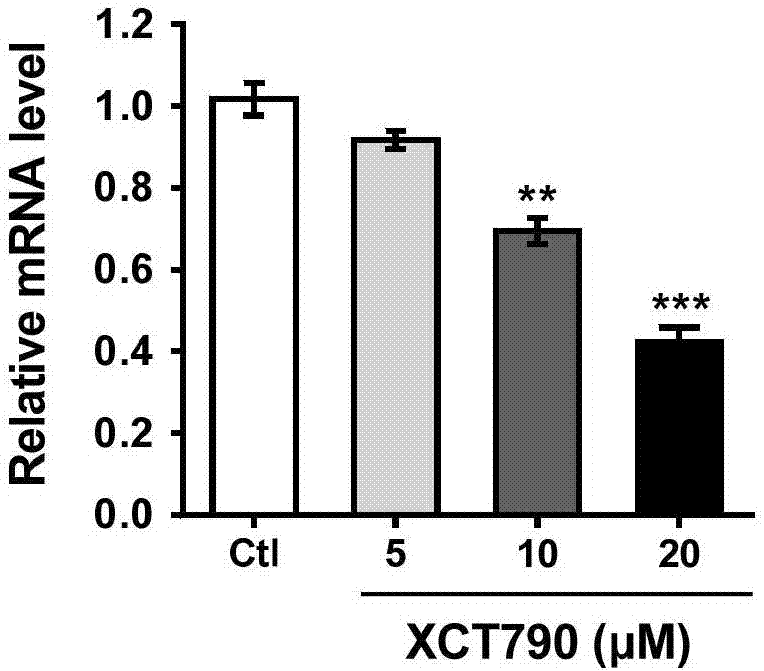Application of estrogen-related receptor alpha as diagnostic marker for cutaneous squamous cell careinoma and related application of application
A technique for squamous cell carcinoma and diagnostic marker, applied in the fields of molecular biology and tumor prevention and treatment, to reduce recurrence and improve survival rate
- Summary
- Abstract
- Description
- Claims
- Application Information
AI Technical Summary
Problems solved by technology
Method used
Image
Examples
Embodiment 1
[0032] The fluorescence quantitative PCR experiment was used to test the transcriptional regulatory activity of XCT790 and ERRαshRNA on ERRα in A431 (human skin squamous carcinoma cells).
[0033] This example illustrates that XCT790 and ERRα shRNA involved in the present invention can effectively inhibit the transcription of ERRα gene in human skin squamous carcinoma cell A431, indicating 1) ERRα mRNA is expressed in human skin squamous carcinoma cells, and the expression level is higher than normal Skin cells; 2) Using XCT790 or ERRαshRNA significantly down-regulated the level of ERRαmRNA in A431. Fluorescence quantitative PCR testing technology is a technology familiar to workers in the field.
[0034] 1. Cell plating:
[0035] Warm the DMEM cell culture medium and pancreatin with 10% FBS at 37℃ in advance, wipe the sterile operation table with alcohol for sterilization, wipe the pancreatin and DMEM cell culture medium with alcohol and put it into the sterile operation table, and...
Embodiment 2
[0067] Western Bloting was used to test the effect of XCT790 and ERRαshRNA on the expression level of ERRα protein in A431 (human skin squamous carcinoma cells). Western Bloting cell proliferation experiment is a technique familiar to workers in the field.
[0068] 1. Extract the total protein of A431 cells
[0069] After XCT790 or ERRαshRNA intervenes for the corresponding time, aspirate the old culture medium in the original cell culture class, wash the cells 2-3 times with pre-cooled PBS, and add 200μL of cell RIPA lysis solution to each well of the 6-well plate (before use A few minutes ago, PMSF was added to the final concentration of 1μM), and the lysate was in full contact with the cells after a few blows with a gun. After 1-2s, the cells are fully lysed. After sufficient lysis, collect the cells with a cell scraper on ice. Use a pipette to transfer the lysate into a 1.5 mL centrifuge tube, mix by pipetting, and place on ice for 30 minutes. Centrifuge at 12000 rpm at 4°C...
Embodiment 3
[0099] The CCK-8 cell proliferation experiment was used to determine the proliferation inhibitory effect of XCT790 and ERRαshRNA on A431 (human squamous carcinoma cells).
[0100] This example illustrates that the ERRα involved in the present invention can effectively inhibit the proliferation of human skin squamous carcinoma cell line A431 after being down-regulated by the specific inverse agonist XCT790 or shRNA. The proliferation of cancer cell lines in vitro shows extremely important key effects. The CCK-8 cell proliferation experiment is a technique familiar to workers in the field.
[0101] 1. A431 cell culture and seeding 96-well cell culture plate:
[0102] Take out the A431 in good logarithmic growth phase and observe the cell morphology, if the cells have been 80% confluent, start to passaging. Wash the old culture medium in the petri dish, wash 3-5 times with sterile 1mL PBS, add 1 mL of warm-bathed pancreatin, shake the petri dish horizontally to make the pancreatin eve...
PUM
 Login to View More
Login to View More Abstract
Description
Claims
Application Information
 Login to View More
Login to View More - R&D
- Intellectual Property
- Life Sciences
- Materials
- Tech Scout
- Unparalleled Data Quality
- Higher Quality Content
- 60% Fewer Hallucinations
Browse by: Latest US Patents, China's latest patents, Technical Efficacy Thesaurus, Application Domain, Technology Topic, Popular Technical Reports.
© 2025 PatSnap. All rights reserved.Legal|Privacy policy|Modern Slavery Act Transparency Statement|Sitemap|About US| Contact US: help@patsnap.com



